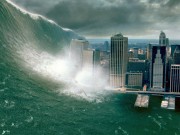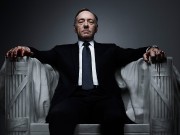Not since Citizen Kane has a filmmaker produced something so daring and damning of another man’s legacy. Paul Thomas Anderson’s The Master certainly has its similarities to the life and philosophies of Scientology founder L. Ron Hubbard. By itself, the film is a masterwork of genius from top to bottom. Following the quasi-friendship between two men who make stuff up, we see a battle between these men, and the battles they have with themselves.
Freddie Quell (Joaquin Phoenix), like many who served in World War II, is not entirely fit to re-assimilate into American society. He has a penchant to drink, and if liquor is not around, he can concoct anything to blur and alter his reality. After a seemingly brief interment in a hospital after the war, he becomes a drifter, taking on a variety of odd jobs, specifically as a portrait photographer in a department store. But each occupation is doomed when he becomes violent, usually as a symptom of his drinking. After running for so long, Freddie wakes up on a boat and is greeted by “the Master,” Lancaster Dodd (Philip Seymour Hoffman), a man who is preaching his own pseudo-science as a religion, and slowly gaining a following.
Although not an official battle cry of war against the Church of Scientology, the resemblance between Lancaster and L. Ron Hubbard, and their respective self-help books, the fictional The Cause and Dianetics. Scientology, whose dubious history and intentions haven been called a cult, has been known to feverishly attack, both physically and litigiously, those who are deemed antagonistic towards the group. Thus, to prevent an all-out war between Scientology and Director Paul Thomas Anderson, it is imperative to remain quiet (which he usually does) and not call the film an official analogy.
Both Freddie and Lancaster both like to make stuff up. Freddie, who can barely handle sobriety, will create any sort of drinkable liquid to inebriate himself, regardless of its contents. He works like a pseudo-chemist, mixing liquids together, shaking, stirring, and mashing them to produce any high. Lancaster on the other hand, is making up a religion and mythology based around pseudo-science. Using hypnosis, he believes he can touch upon the distant lives of one’s past to cure diseases of their present; to fix a damaged soul and return it to its natural perfection. Together, when their concoctions mix, it becomes a battle between men who make stuff up, and their friendship is dependent on it. Yet, they both seem to enjoy each other’s company and made up concoctions.
The film’s climax has similarities with Anderson’s previous film There Will Be Blood, in fact, most of the film does. Freddy visits Lancaster’s sprawling school in London, only to come face to face with him one last time, and the conclusion to their relationship is that they will become eternal enemies, much like Plainview and his son. This disconnection policy exists in real life in Scientology.
While the society that Lancaster has surrounded himself with calls him the Master, he may not be as in control as others might think. Peggy Dodd (Amy Adams), Lancaster’s wife and faithful devotee to the Cause, has a few scenes where she exhibits an uncanny control over Lancaster, keeping him in line, and often times literally dictating the rhetoric and direction of the Cause. As interesting note, Adams was asked to remain on set, even when she was not included in a scene, just to make her presence felt.
The Great Man theory poses that individual men (and for some reason it is always men) shape history. If we study things carefully, it is those who are employed by these Great men and the social environment that were responsible for magnificent changes. The same goes for Thomas Edison, Steve Jobs, Napoleon, and many more. As we seen in The Master, Dodd takes credit for creating something that captivates his growing numbers of followers, but it is his wife who keeps him in line.
Phoenix’s previous film, I’m Still Here, was a mockumentary that chronicled his journey tricking the world into believing he was going through a spiritual and occupational transformation, which many found to be a desperate cry for help during a personal and professional crisis. The film was the perfect experience and exercise in the Method, an essential necessity to pull off his amazing performance in The Master. His face expresses the darkened soul of a man defeated by war, heartbreak, and substance abuse. Hoffman also provides a powerful performance as a man determined to fix a world and a human race that has not seen perfection for trillions of years. You read that right, trillions. Phoenix, Hoffman, even Adams, and the many secondary characters have never been better.
Rather than list all the blatant analogies between The Master and Scientology, which many other critics will provide, it may be more original to focus on the inherent beauty and meaning of the film. Shot on 65mm—and if available—screened in 70mm to lucky theaters, The Master is returning to an old Hollywood stand-by during uncertain box office profitability. The late 1940s and through the late-1960s, Hollywood had an entire generation of poor box office profits. Much like 3D, smell-o-vision, and many other gimmicks during this time, the industry tried to throw everything at the screen, and the audience, in hopes that something stuck. The only gimmick, if you can call it that, that stuck was widescreen. Not only did films get wider, they got bigger, something that ten inch television sets could not compete with.
Some of the greatest films of the 1950s and 60s were shot on 70mm film and other larger resolutions. The Searchers and Vertigo are among these films, both which have appeared on Sight & Sounds greatest films list. Here, The Master takes on this larger resolution, providing a crisp image that encompasses the entire frame, distorting our views of the characters, particularly because their view of the world is distorted as well. Despite the larger film format and camera size, the lens is placed between, in, and on top of objects and in locales rarely offered by other filmmakers. One scene has the camera placed on top of the rail of a ship. The left side: Freddie drunk, stumbling from door to door. The right side: a calm ocean.
The analogies are certainly there, even if distributor and producers deny it. Even Orson Welles denied any knowledge or wrong-doing that his radio performance of The War of the Worlds would have any drastic circumstances of society. Admitting such things is suicide for their art; that is why Welles’ Kane and War of the Worlds are historic treasures, and so is The Master.









